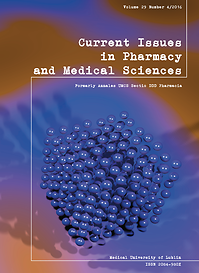Analysis of mutation and promoter methylation of TP53 gene in tumors of the head and neck
DOI:
https://doi.org/10.1515/cipms-2016-0011Keywords:
mutation, methylation, head and neck, cancer, TP53Abstract
According to current World Health Organization data, worldwide, cancer is second to cardiovascular diseases as the leading cause of death. The p53 protein is a translation product of theTP53gene, and it has many functions in cells. Indeed, for this, it is commonly called the “guardian of the genome”. The aim of this study was to evaluate the prevalence of mutation and methylation in the promoter of theTP53gene in cells affected with squamous cell carcinoma of the head and neck. The research material consisted of 34 DNA samples isolated from surgically removed tissue fragments of head and neck tumors. In this work, analysis of all samples for the presence of mutations proved negative. This result simultaneously revealed an absence of mutation in theTP53gene promoter in the analyzed material. However, the detection of changes in the methylation profile status of the promoter of theTP53gene in the DNA samples revealed the presence of both methylated alleles in 76.5% of the sample population, while in the remaining 23.5%, methylation was present in only one allele of the studied gene. In our work, we assumed that samples displaying methylation involving two alleles will show greater predisposition to the development of a malignant tumor. The obtained results reveal that despite the lack of mutation in theTP53gene promoter, its functioning may be impaired by other mechanisms – either epigenetic or environmental.
References
1. Bai L., Zhu W.G.: p53: Structure, functions and therapeutic applications, J. Cancer. Mol., 2(4): 141-153, 2006.
2. Blons H., Laurent-Puif P.: TP53 and head and neck neoplasm, Hum. Mutat., 20: 252-257, 2003.
3. Costello J.F., Plass C.: Methylation matters, J. Med. Genet., 38: 285-303, 2001.
4. Hsieh Y.Y., Wang J.P., Lin C.S.: Four novel single nucleotide polymorphism within the promoter region of p53 gene and their associations with uterine leiomyoma, Mol. Reprod. Dev., 74:815-820, 2007.
5. Lane D.P.: Cancer. P53 guardian of genome, Nature, 358: 15-16, 1992.
6. Lis P., Niczyj-Raucy M., Lis M.: The molecular basis of cancer and genetic methods of its diagnosis, Nat. J. (Opole), 44: 92-119, 2011.
7. Nylander D.M, Dabelsteen E., Hall P.A.: The p53 molecule and its prognostic role in squamous cel carcinomas of the head and neck, J. Oral. Pathol. Med., 29 (9): 413-425, 2000.
8. Rusin P., Markiewicz L., Majsterek I.: Genetic predeterminations of head and neck cancer, Post. Hig. Dos., 62: 490-501, 2008.
9. Sznarkowska A., Olszewski R., Zawacka-Pankau J.: Farmakologiczna aktywacja supresora nowotworu, natywnego białka p53 jako obiecująca strategia zwalczania nowotworów, Post. Hig. Med. Dos., 64: 396-407, 2010.
10. Wawryk-Gawda E., Chylińska-Wrzos P., Lis-Sochocka M. Chłapek K., Bulak K., Jędrych M., Jodłowska-Jędrych B.: P53protein in proliferation, repair and apoptosis of cells, Protoplasma, 251 (3): 525-533, 2014.
11. Wojtasiński Z.: Ponad 14 mln nowych zachorowań na nowotwory na świecie, http://naukawpolsce.pap.pl/aktualnosci/news,402029,ponad-14-mln-nowych-zachorowan-na-nowotwory-na-swiecie.html.
Downloads
Published
Issue
Section
License
Copyright (c) 2016 Authors

This work is licensed under a Creative Commons Attribution-NonCommercial-NoDerivatives 3.0 Unported License.


